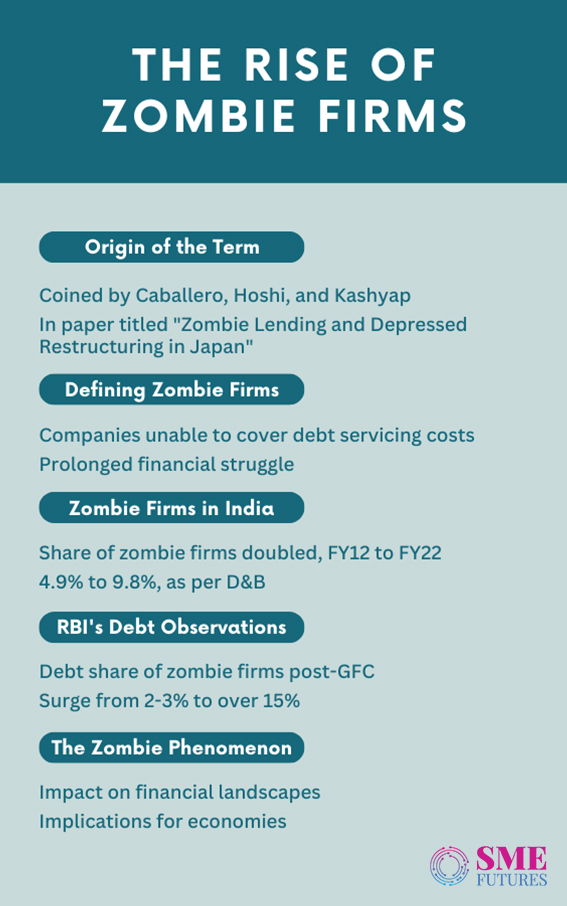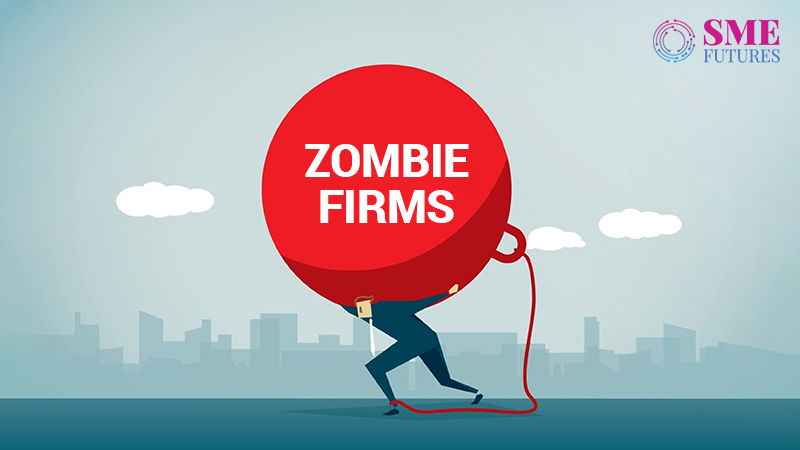Air India, MTNL & BSNL, HMT Limited & Hindustan Photo Films have one thing in common. They have all been categorised as zombie firms.
Why are they called zombie firms, you ask?
In India, as in many other economies, zombie firms are companies that are effectively insolvent but continue to exist, frequently with the help of loans, subsidies, or other types of financial aid.
Professor Anil Sood, Founder, Institute for Advanced Studies in Complex Choices (IASCC) says, “The term was coined by Caballero, Hoshi and Kashyap in their paper titled, ‘Zombie Lending and Depressed Restructuring in Japan.’ The paper suggested that “the widespread practice of Japanese banks of continuing to lend to otherwise insolvent firms” was the reason for Japanese stagnation post the asset price collapse in the early 1990s.”
Dr Arun Singh, Chief Global Economist at D&B says that there exists no universally standardised definition for zombie companies. “They are generally characterised as entities with an Interest Coverage Ratio (ICR) of less than 1 consistently for a minimum of three consecutive years and a history of at least a decade in existence,” he explains.
ICR is a measure of a company’s ability to meet its interest payments.
“The inclusion of the second criterion – age – is necessary because start-ups may need a few years to pass by before investment projects start to deliver returns. Some variations of this definition also incorporate negative revenue growth as an additional indicator,” he adds.
Zombies are increasing
Recently, an IMF working paper revealed that over the last two decades, zombie firms have steadily been increasing, especially after the global financial crisis. According to this research, after a temporary downward trend from 2016 to 2019, the number of zombie firms has resumed its upward trend since the COVID-19 pandemic, presumably reflecting the unprecedented policy support and easy financing conditions during that period.
During the recent years, specifically post the global financial crisis and now the pandemic, there has been a sharp increase in research about the banking system’s role in creating zombie firms. Banerjee and Hofmann suggest that there has been an increase in zombie firms since the late 1980s, and the increase is “linked to reduced financial pressure, which in turn seems to reflect in part the effects of lower interest rates”. They also suggest that zombie firms are less productive and cause their more productive peers to lower their employment and investment levels.
Talking about India, one RBI study describes a sharp increase in the proportion of zombie firms in India, post the global financial crisis (GFC).
The study defines a zombie firm as being characterised by a higher than median leverage, an interest coverage ratio of below 1, risky ratings, and increasing debt. It observes that the debt share of zombie firms has gone up from a low of about 2-3 per cent to a peak of more than 15 per cent since the GFC.
“This study finds zombies to be highly leveraged, earning negative return on assets and borrowing more to survive rather than investing to grow. RBI observes that the effectiveness of accommodative monetary policy ‘gets dampened at the margin by zombies who tend to use borrowed resources, including long-term bank loans, less for new investment and more for survival’,” says Professor Sood about the study.

This is bad news for the economy
“The rise of zombie companies poses significant drawbacks to the economy,” says Dr Singh.
He explains why, saying, “These companies exert a detrimental influence by depressing market prices, distorting credit allocation, and crowding out both investment and employment at healthy firms. These disruptions impede business dynamism and weigh on the aggregate productivity of the economy.”
Furthermore, zombie firms suppress wage growth, as they do not generate sufficient profits to invest in their employees. Additionally, they pose risks to the banking sector as they face increased risks due to potential loan defaults from these struggling entities, contributing to financial instability, he adds.
Factors contributing to the surge
Globally, a confluence of factors has contributed significantly to the proliferation of zombie companies over the past two to three decades, which have almost doubled between FY12 and FY22.
Dr Singh highlights the reasons behind this phenomenon.
Firstly, weakened financial regulation has emerged as a key catalyst. Financial institutions burdened with weak balance sheets find themselves inclined to perpetuate or restructure loans for zombie enterprises rather than opting for necessary write-offs.
Secondly, the absence of robust insolvency and bankruptcy frameworks acts as a deterrent to effective corporate restructuring and amplifies creditors’ inclination toward forbearance.
In the wake of the global financial crisis, numerous countries implemented monetary easing measures, leading to a protracted period of exceptionally low interest rates. This serves as a double-edged sword. On one hand, it incentivises banks to extend support to zombies. On the other hand, it encourages zombies to accumulate more debt.
Lastly, fiscal support measures have played a major role in keeping bankruptcy rates at artificially low levels.
Once a zombie, always a zombie?
Once upon a time, co-working behemoth WeWork stood tall with whooping valuations. But its stock market debut never happened, and its IPO plans never worked out. Furthermore, analysts had their eyes on its financial proceedings, which felt shady in a lot of ways.
While, it is a prime example of a zombie, the company recently filed for bankruptcy, according to media reports.
Now, the most important question, of course, is: Can zombie firms recover to become healthy drivers of economic growth?
The answer, as always, is: It depends!
According to Professor Sood, it depends on the economic environment that these firms are operating in and their business and financing strategies.
“A zombie firm can increase its probability of success if it is able to raise equity or convert some of its debt to equity, and thus lower its interest as well as loan repayment burden. If the zombie firm is earning positive operating margins, financial restructuring will definitely help,” he asserts.
On the other hand, if a zombie firm is making operating losses, it must restructure costs and then work towards raising revenue once the demand environment turns benign. A zombie can also look at the possibility of merging with a healthier firm, once it has achieved a competitive cost structure.
“The status of a zombie firm can technically be reversed if it improves its interest coverage ratio to above one for two consecutive years. A company can also exit the zombie status if it achieves two consecutive years of positive revenue growth,” he adds.
However, there is no doubt that zombie firms hurt healthier firms. The non-zombies in the industries with a greater number of zombie companies tend to experience lower Total Factor Productivity (TFP), investment and employment growth. Furthermore, the IMF study notes that the non-zombies in industries with a higher concentration of zombie businesses tend to quit the market faster, and entry rates are lower, implying that their presence impacts the market negatively. However, their ability to recover and contribute positively to the economy depends on various factors, making it a complex issue overall.











